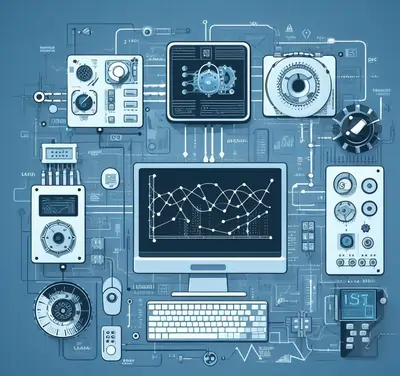A Comprehensive Guide to Designing Digital Control Systems in MATLAB

- Control System Basics
- Controller: At the heart of every control system is the controller. This component acts as the decision-maker, processing information and generating control signals to manipulate the system's behavior. Controllers come in various types, such as PID (Proportional-Integral-Derivative) controllers, state-space controllers, or more advanced variants depending on the specific application.
- Plant: The plant, often referred to as the "system," is what the control system is designed to control or influence. It can be any dynamic system, from a simple mechanical system like a car's suspension to complex industrial processes like chemical reactors or aircraft flight control systems.
- Feedback: Feedback is a critical feature of control systems that enables them to adjust and adapt in real-time. It involves measuring the output (or state) of the plant and comparing it to a reference or desired value. The difference between the desired and actual values, known as the error signal, is used by the controller to make control decisions and maintain or regulate the system within desired limits.
- Analog vs. Digital Control
- Analog Control: Analog control systems operate with continuous signals. In these systems, both the controller's input and output are continuous-time signals, typically represented as voltages or currents. Analog controllers use continuous functions to manipulate the plant's behavior. While they can be highly accurate and precise, they may struggle with certain types of systems, especially those involving digital components, as they require interface circuitry for integration.
- Digital Control: Digital control systems, on the other hand, use discrete-time signals and discrete controller operations. These systems sample the system's state or output at fixed intervals and process this data digitally using algorithms. Digital control systems are particularly well-suited for systems that involve digital components or require complex algorithms for control. They offer several advantages, including ease of implementation, flexibility, and the ability to handle nonlinear systems.
- Discrete-Time Systems
- Sampling: In discrete-time systems, the plant's output is sampled at discrete time points, creating a sequence of data points. This process converts a continuous signal into a series of discrete values.
- Digital Processing: Once the data is sampled, it can be processed digitally, which means that mathematical algorithms and computations can be applied to manipulate and control the system. This enables the implementation of sophisticated control strategies that may not be feasible in analog systems.
- Digital Signal Processing (DSP): Discrete-time systems are closely related to digital signal processing, a field that deals with the analysis and manipulation of discrete data sequences. DSP techniques are essential for designing digital control algorithms.
Digital control systems play a pivotal role in modern engineering applications, offering precise and efficient control over various processes. MATLAB, a versatile computational tool, provides a powerful platform for designing and implementing digital control systems. In this comprehensive theoretical guide, we will delve into the essential steps involved in designing a digital control system in MATLAB. This knowledge will not only help students understand the theoretical foundations but also assist them in identifying the best way to solve their digital control system assignment using MATLAB, helping them tackle real-world engineering challenges.
Understanding Digital Control Systems
Before we jump into the steps of designing a digital control system in MATLAB, let's establish a strong theoretical foundation by understanding the core concepts:
A control system is a foundational concept in engineering and automation, serving as the backbone for regulating and managing the behavior of various dynamic systems. Here, we'll break down the key components of a control system:

In essence, a control system's primary purpose is to ensure that the output or behavior of the plant matches the desired or reference value, even in the presence of disturbances.
Control systems can broadly be categorized into two types: analog and digital. Understanding the distinction between these two approaches is crucial for designing effective control systems:
The key advantage of digital control is its ability to process data and implement control strategies with a high degree of precision, making it suitable for a wide range of applications, from robotics to industrial automation.
Discrete-time systems play a pivotal role in digital control systems. They differ from continuous-time systems in that they operate on sampled data, typically at fixed intervals. Here's why understanding discrete-time systems is crucial:
Understanding discrete-time systems and their role in digital control is vital for effectively designing and implementing control systems that operate in the digital domain. It allows engineers to harness the power of digital processing and apply advanced control strategies to achieve precise and adaptive control over dynamic systems.
MATLAB as a Design Tool
MATLAB is a powerful software environment for designing and simulating control systems. Here are the initial steps to get started:
- MATLAB Installation: Ensure MATLAB is correctly installed on your computer, and you have access to the Control System Toolbox, which provides essential functions for control system design.
- Starting MATLAB: Familiarize yourself with the MATLAB interface and basic commands. This includes the MATLAB Command Window, the Script Editor, and the Workspace.
Modeling the System
Before you design a digital control system, you need to create a mathematical model of the physical system you want to control:
- System Identification: Determine the system's transfer function, state-space representation, or any other suitable model based on the system's physical characteristics.
- Transfer Function Representation: Express the system's dynamics as a transfer function, often in the form of G(s) = Y(s) / U(s), where G(s) represents the system's behavior.
Designing the Controller
Now, let's focus on designing the digital controller using MATLAB:
- Controller Selection: Choose an appropriate controller type, such as a PID (Proportional-Integral-Derivative) controller, state-space controller, or other specialized controllers based on system requirements.
- Controller Design: Utilize MATLAB's control design tools, like 'pidtune' or 'place,' to design the controller while considering system stability, performance, and transient response.
Discretization
- Continuous to Discrete Conversion: As digital control systems operate in discrete time, convert the continuous-time controller to a discrete-time controller using MATLAB's 'c2d' function.
Simulating the System
- Simulating the Control System: Create a Simulink model or use MATLAB scripts to simulate the closed-loop control system. This step allows you to analyze the system's behavior under different conditions and refine the controller design if necessary.
Analysis and Optimization
- Performance Analysis: Utilize MATLAB's analysis tools to assess the system's performance, including step responses, frequency responses, and stability analysis.
- Optimization: Fine-tune the controller parameters to meet the desired performance specifications, such as settling time, overshoot, and steady-state error.
Implementation
Once satisfied with the controller's performance, it's time to implement the digital control system:
- Hardware Integration: If the control system needs to interface with physical hardware, ensure that you have the necessary hardware drivers and communication protocols in place.
- Real-Time Control: Implement real-time control using MATLAB's Real-Time Workshop or external hardware-in-the-loop (HIL) systems if required.
Testing and Validation
- Testing: Validate the digital control system in a controlled environment. Verify that it behaves as expected under different scenarios and perturbations.
- Documentation: Document the entire design process, including controller parameters, system models, and simulation results, for future reference and reporting.
Conclusion
Designing a digital control system in MATLAB is a multifaceted process that requires a solid theoretical foundation, a deep understanding of control system principles, and proficiency in MATLAB's tools and functions. This theoretical guide has provided university students with a comprehensive overview of the essential steps involved in designing digital control systems. Armed with this knowledge, students can confidently complete their MATLAB assignments and real-world control system challenges, making them well-prepared for careers in engineering and automation. Remember that practice and hands-on experience are essential for mastering this complex yet rewarding field of study.